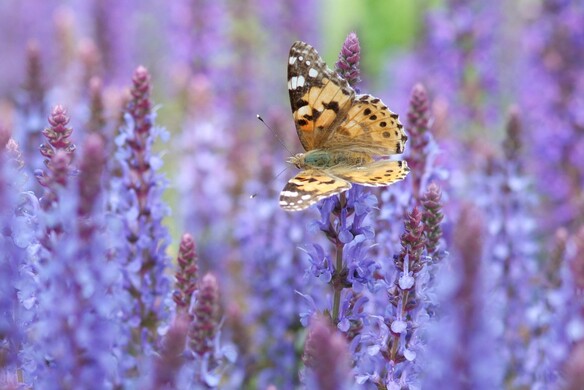With its variety of colours, Salvia is a real asset to your garden. This plant holds up well in dry periods and will flower endlessly. The flowers and the leaves are both fragrant.
Lipped flowers
Bees and butterflies love to treat themselves to the nectar in the flowers. The flower shape clearly indicates that Salvia belongs to the lipped flower family. The English name for Salvia is sage. Salvia nemorosa, also known as woodland sage, is best known for its many varieties and mostly purplish-blue flowers. There are also many other varieties, however, with flowers in all the colours of the rainbow. Growth heights vary, but they have their unusual square stems in common. The stems of Salvia pratensis (meadow sage) are dark in colour. Its violet-blue flowers make for a beautiful contrast against this.

Salvia varieties
Most varieties are hardy. But be careful: some varieties are less hardy. Salvia uliginosa (bog sage, which thrives on dry soil, as it happens), for example, can only tolerate frost up to a maximum of -10°C. In areas with harsh winters, it is best to protect these plants with a mulch layer of organic material, such as leaves, hay or prunings. This Salvia showcases its azure-blue flowers from August through October and can grow as tall as 1.5 metres. Salvia microphylla ‘Hot Lips’, with its cute red and white coloured flowers and tiny leaves, is also moderately hardy. Salvia greggi will flower from June until the first frost and is available in a whopping 20 different colours.
Colour in autumn
Give Salvia a sunny, sheltered spot with well-drained soil. You could combine different Salvia varieties or combine one variety with other perennials. In summer, around June, you can prune Salvia right below its top. After a few weeks, you will be rewarded with a second flowering, so there will be plenty of colour in autumn. Do not prune back the entire plant until after winter, to encourage new shoots to grow from the bottom.

Interesting fact
Salvia’s name is derived from the Latin word salvus, meaning healthy. The name relates to the medicinal properties of Salvia officinalis (common sage).
You can find more tips and inspiration about perennials at www.perennialpower.eu.
To view Salvias at Crocus click here
All images copyright iVerde ‘Perennial Power’
If you have enjoyed reading our blog post then why not fill in the form provided to allow us to send you our blog posts and newsletters by email. For all major gardening products, visit our shop from the menu above.

